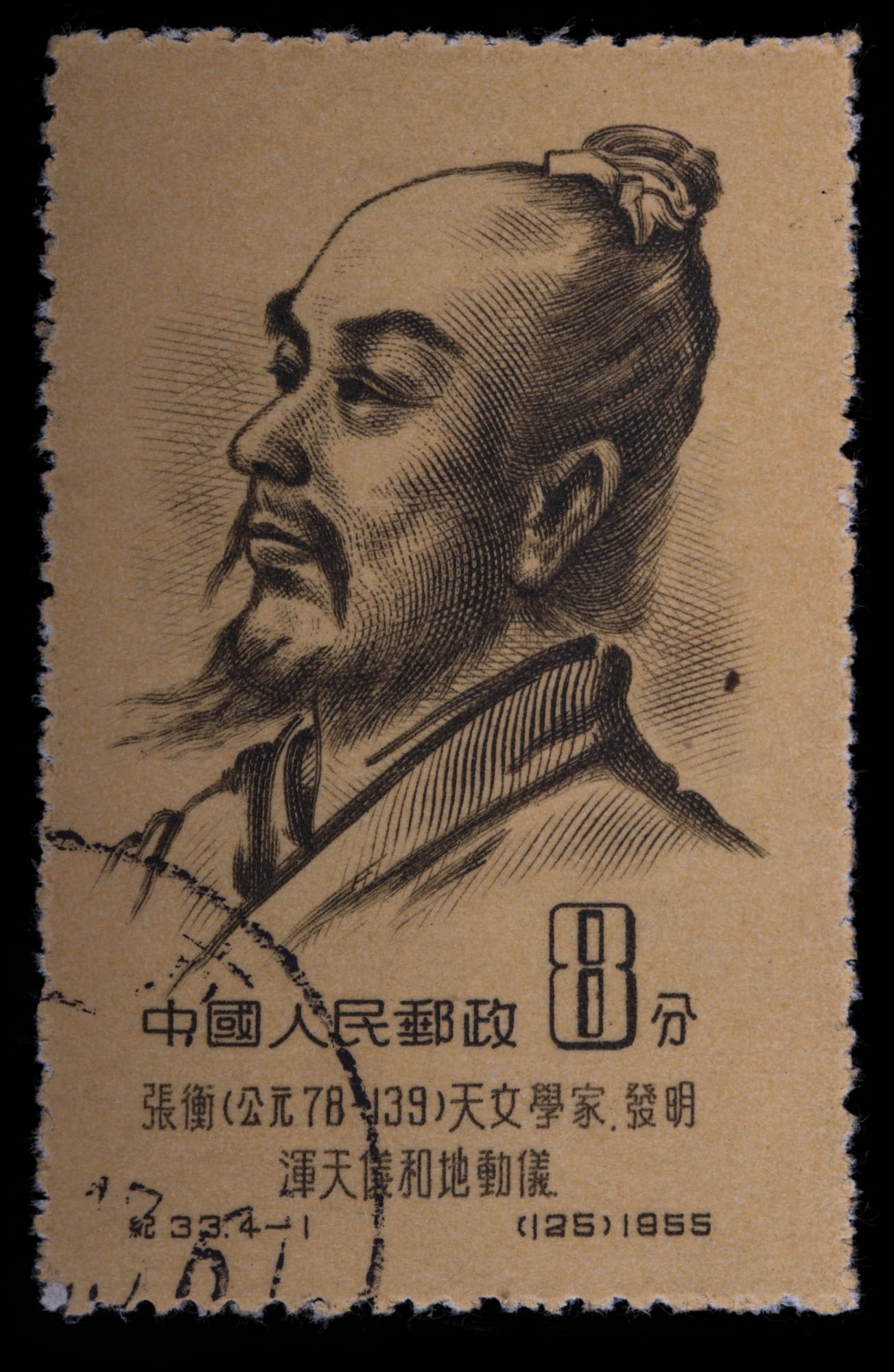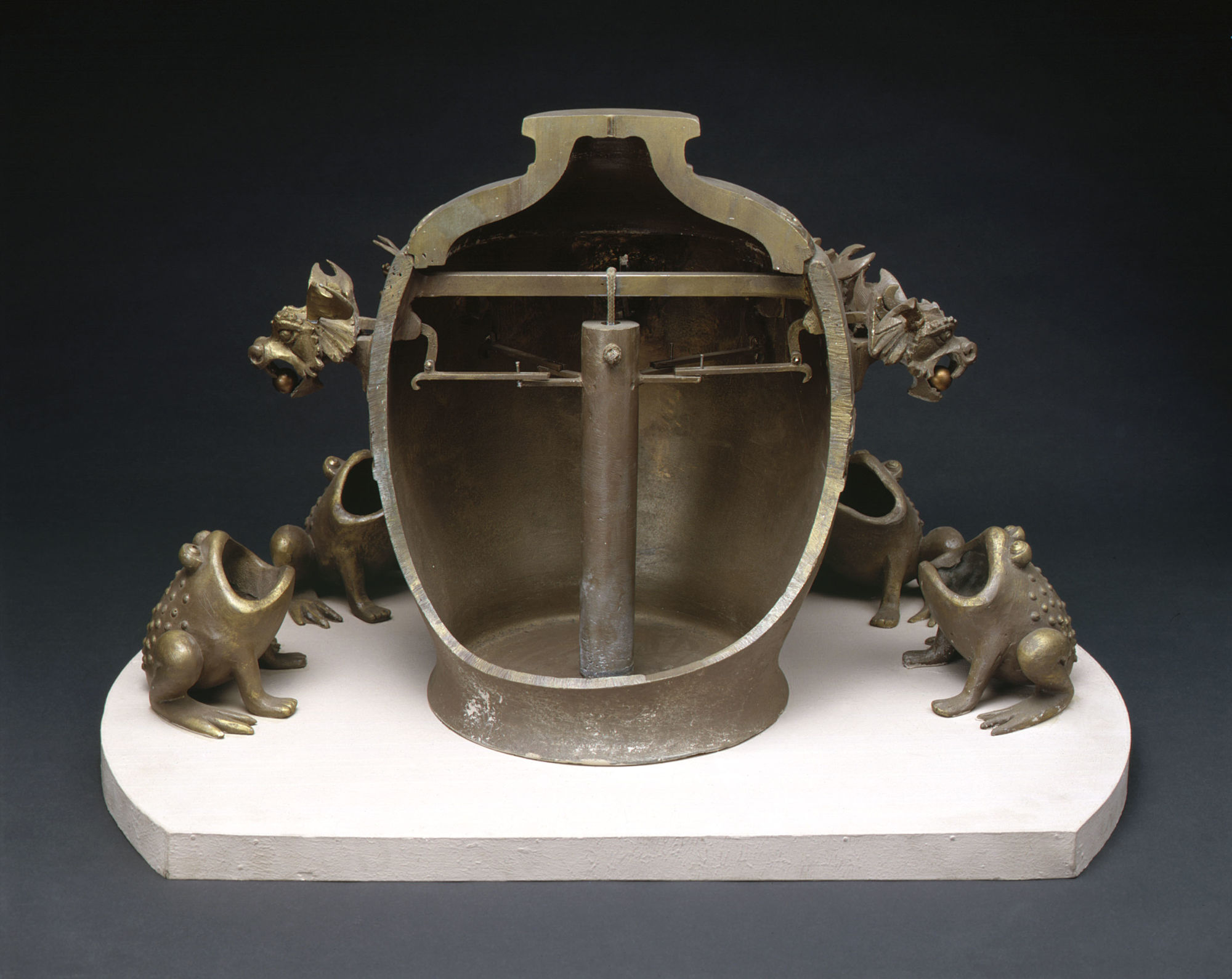What natural events led the Chinese to invent the seismograph?
Modernistic seismographs are extremely sensitive pieces of equipment. Past recording the slightest movements of laser light or magnets, these devices can detect the smallest of rumbles even when we tin't sense them. In that location are networks of thousands upon thousands of seismographs prepare across the globe that can accurately determine the epicenter of an earthquake -- its indicate of origin. And with all the data these clusters produce, we are constantly improving our understanding of these geological events, developing early warning systems and figuring out how to build the safest structures. We have technology on our side, of course, and yet the blueprint of the primeval convulsion detection device isn't that different from today'southward versions. Simply it was created well-nigh 2000 years ago, before people even understood what an earthquake was.
Zhang Heng lived in China during the Han dynasty, and history remembers him equally a scholar in many fields. He dabbled in astronomy, mathematics, science, engineering science, cartography and verse, amidst other fields of written report and artistic pursuits. He served as a government official for much of his adult life, and was invited to the regal courtroom in his mid-30s by Emperor An in accolade of his skills as a mathematician.
He worked on computing pi, mapped stars, and in tandem with his academic career, was an inventor. He improved the accurateness of arrival clepsydra -- a type of water clock that measures fourth dimension past the menstruum of liquid -- and is credited with creating the first water-powered armillary sphere (a dynamic model that illustrates the motion of celestial objects). But Zhang Heng is most famed for inventing the world'south first seismoscope.

He introduced his device to the purple court in the capital of Luoyang in Ad 132, 7 years before his death Advertizing 139. While at that place are no surviving physical remnants or illustrations of his seismoscope, historical descriptions depict it equally being a big statuary musical instrument, similar in shape to an urn or a vase. Mounted on the outside of this were eight dragons, each with a bronze brawl clasped within its jaw. Directly underneath these mythical protrusions were eight statuary toads, mouths agape to receive the balls if they fell.
Aboriginal texts are a piddling hazier on the inner-workings of the seismoscope. Information technology's generally believed, still, that inside the hollow body of the seismoscope hung a pendulum, while lever mechanisms connected to each of the dragons flanked this pendulum on all sides. The shockwaves of an earthquake would crusade the pendulum to swing, activating one of the mechanisms within. The corresponding dragon would gift its brawl to the toad, informing the court that not only had an earthquake occurred, simply from which general direction the tremors came. You lot see, each dragon and toad related to a compass point -- north, northwest, due west, and then on -- so the government would know where to send aid.


Zhang Heng's invention was initially met with skepticism. His views on certain topics made him unpopular with some of his peers, and worse yet, his seismoscope was unproven. Simply equally the story goes, several years later, a brawl finally dropped. This in and of itself wasn't prove information technology worked, of course -- no convulsion had been felt in the capital -- but days afterward a messenger arrived to written report of a serious earthquake that originated hundreds of miles away, off to the west of Luoyang in the direction the at present empty dragon oral fissure faced.
Zhang Heng called his seismoscope Houfeng Didong Yi, significant an "instrument for measuring the seasonal winds and the movements of the Earth." While many people of his time believed earthquakes had spiritual catalysts, he and a collection of other scholars were of the stance the events were acquired past winds and changes in air pressure -- begetting in heed this was way, way before the seed of plate tectonic theory sprouted in the early 20th century.
In the centuries later on Zhang Heng's death, other Chinese intellectuals were said have created successor seismoscopes of his design. Since nothing tangible survived the passage of time, however, historians of our era have struggled to reconcile these centuries-sometime accounts with a working replica of Zhang'southward device. Some even speculated information technology never existed. While the ornate nature of the seismoscope was well described, the exact mechanisms driving it weren't. Attempts to reinvent it in the 19th and 20th centuries proved unsuccessful. It remained unclear, for instance, how an ancient pendulum design could exist sensitive enough to notice earthquakes hundreds of miles away. Furthermore, how could the movement trigger just 1 mechanism and spare the others?
In 2005, a group of seismologists and archaeologists from the Chinese Academy of Sciences appear they had created a proven, operation replica. In their version, the pendulum itself doesn't interact with any levers; instead, information technology's suspended higher up some other ball perched atop a thin pedestal. When the pendulum swings, it nudges that key ball downward one of viii channels, where it hits a trigger system that animates the external dragon rima oris. We don't know this is exactly how Zhang's model worked, of course, merely it shows that only a minor reinterpretation of how the seismoscope is described in historical texts can lead to the creation of a sensitive, direction-aware device.
Fifty-fifty though Zhang'due south device is about 2 millennia old, the working principle behind information technology is yet ordinarily used today. A popular course of modernistic seismograph uses exactly the aforementioned backdrop of inertia, whereby a static base and hanging pendulum move independently of each other when the ground shakes. Only nowadays the pendulum is a magnet, and the induced current its swinging produces in the conductive base is the record. Converting the fluctuations into a digital signal allows such seismographs to document tremor intensity, their timespan, etc. Zhang's invention noted the simple occurrence of an earthquake, hence the proper noun seismoscope.

The backwash of a 6.5-magnitude earthquake that struck China's Yunnan Province in August 2014
VCG via Getty Images
While Zhang's original design has more or less survived the exam of time, we're however coming up with new monitoring techniques. Researchers at Stanford appear terminal year, for instance, that they had developed a method of detecting earthquakes using existing fiber optic cables. Predicting earthquakes earlier they happen, though, is something nosotros're far from mastering. The best we tin really practice at the moment is utilize seismographs to warn of impending shockwaves just afterwards an earthquake has struck. Typically, though, this heads-up is only a affair of seconds.
Our awareness of shifting tectonic plates gives us the ability to vaguely surmise where earthquakes could happen in the future. Attempts at more precise techniques have shown hope, only to be relabelled unreliable later. At that place is some anecdotal evidence, however, that animals can showroom strange behavior upward to several days earlier an earthquake.

The most reliable written report of this phenomenon was published in 2010. Most an entire colony of toads a biology post-grad was studying inexplicably abandoned spawning and left the pond they called home over the course of a few days. 5 days afterward the toads initially began displaying strange beliefs, an convulsion struck 74 km from the site. It's thought emissions from the surrounding earth as it reached maximum stress changed the chemical limerick of the habitat, causing this reaction in the toads.
It's bizarrely casual that these creatures featured in both the first credible study of the phenomenon, and and then heavily in the design of the first seismoscope. Or mayhap, all those centuries agone, Zhang had already figured out they had a predictive capacity far beyond our own.
All products recommended by Engadget are selected by our editorial squad, contained of our parent company. Some of our stories include affiliate links. If you lot purchase something through one of these links, we may earn an affiliate commission.
Source: https://www.engadget.com/2018-09-28-backlog-zhang-heng-seismoscope.html
0 Response to "What natural events led the Chinese to invent the seismograph?"
Post a Comment